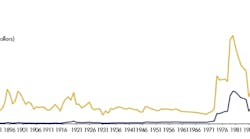The Expanding Role of Sensors in “Smart” HVAC Systems (.PDF Download)
They may be small, sometimes almost invisible, but sensors are essential ingredients in almost every industrial system, whether powered by electricity, water, steam, wind, or waves. They’re going to be even more important in the future as the Internet of Things transforms standalone systems into a network of connected devices, almost all of them having integrated sensors. In fact, they will key players in helping commercial, industrial, government, and other large buildings reap significant energy savings, especially in heating, ventilation, and air-conditioning (HVAC) systems.
Only recently has there been an emphasis on connecting the many sensors within HVAC and other systems together to produce an “intelligent” building. The reasons for that have as much to do with recognition of the need for achieving energy efficiency as they do with the technology required to deliver it.
It’s safe to say that until the 1970s, few people paid much attention to “energy efficiency” at all—and why would they as gasoline and oil prices had remained low for decades? The wakeup call came in 1973’s oil crisis (Fig. 1), followed by another in 2000 that together increased the price of both by an order of magnitude. Energy efficiency could no longer be ignored. So today, achieving the highest possible energy efficiency is a key goal in every industry in which power conservation is essential.
1. It’s not hard to find the point of the “wakeup call,” when oil prices surged around 1973, sagged, and then rose again in the early 2000s. Even though have since dropped (but are still around $73 a barrel), the need for energy efficiency is now well established. (Source: U.S. Energy Information Administration)
Technology, the other primary factor, has advanced dramatically over the years. Smaller digital components have replaced larger analog versions, and wireless-communications components and systems have made huge leaps in performance, miniaturization, and in the sheer number of choices. Together, technology and the awareness of, and need for, greater energy efficiency collectively make possible the creation of more efficient buildings.

